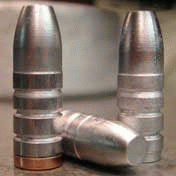Moderator

| I believe the term you are looking for is eutectic, ie lead tin is an eutectic alloy.
Don't know what antimony does to the melting point. |
| | |
one of us
| You will find phase diagrams that will list the melting temperature for the whole range of percentages of two metals alloyed together, such as lead and tin. The eutectic mixture is the that which has the lowest melting point of all the ratios.
Phase diagrams get complicated with more than two elements in the mixture, so you won't see many. |
| | | Posts: 621 | Location: Virginia mountains | Registered: 25 December 2002 |   IP
IP
|
|
one of us
| In the "Cast Bullets" book by the NRA, Ed by Harrison, there is an article by Dennis Marshall, that everyone uses as the reference for lead, lead tin, lead antimony, lead tin antimony alloys.
There are phase diagrams for all the alloys at all concentrations and temperatures.
This is the article to read for reference. - Lew |
| | | Posts: 66 | Location: St. Louis, MO, USA | Registered: 19 August 2001 |   IP
IP
|
|
new member
| Harry the melting point of a mixture will always be lower than the average of its components and often lower than any of its components. How much depends on the physical interaction of the different components. It will also vary to some extent with the heating rate If you are trying to measure these I would sugest that you record the freezing points instead of the melting points. To do this heat the mixture until completely fluid and then remove the heat observe the tempature as it drops. at the freezing point it will stay level or start back up a few degrees. This will give you a point instead of a range.
Langes' Handbook or a handbook of chemistry and physics will have the freeze points (they may be listed a melting points) of many common alloys. |
| | | Posts: 3 | Location: Arkansas | Registered: 26 September 2003 |   IP
IP
|
|
one of us
| I have heard about the NRA book from several people (all recommend it) and have checked the NRA website to try and buy a copy. No luck. Does anyone have a URL to where I could buy it? |
| | | Posts: 212 | Location: Omaha, NE | Registered: 22 August 2003 |   IP
IP
|
|
one of us
| HarryO: The NRA book is long out-of-print; even AbeBooks (my ultimate resource) doesn't currently show a copy. But Dennis Marshall has an excellent article on the lead/tin/antimony alloys in Lyman's 3rd Edition "Cast Bullet Handbook", pp. 43 - 52,a nd I think that is the article most people refer to. Nothing on zinc, though - but lead and zinc are basically incompatible for our purposes anyway. floodgate |
| | |
one of us
| HarryO
The Lead-Zinc Phase diagram is shown on page 45 of Lyman Cast Bullet Handbook above mentioned . They are not soluble under conditions we deal with. Diagram is completely different. The low temperature point for melting, or solidifying, are two and correspond to very very low percentages of lead or zinc.
Segregation of Zinc Lead melt is shown on page 41, figure 1 of the same book.
BA Shooter |
| | | Posts: 126 | Location: Buenos Aires, Argentine | Registered: 21 August 2003 |   IP
IP
|
|
one of us
| I am sorry.Lead Zinc phase diagram is on page 46 and photo is on page 44, Lyman Cast Bullet Handbook, Third Edition
BA Shooter |
| | | Posts: 126 | Location: Buenos Aires, Argentine | Registered: 21 August 2003 |   IP
IP
|
|
one of us
| HarryO: Our Argentine friend is right (thanks, BA!), and I was off-base; the lead/zinc data are also in the same article - it's been some time since I read it through, and I had forgotten. From the diagram, you can "float" the zinc off the mix down to about 1-2% Zn, but can't easily get rid of the rest, and that's enough to louse up your casting. I don't know how adding tin would affect the result; that's 'way out of my league. floodgate |
| | |
one of us
| Tanks for reminding me about the Lyman book. I had forgotten the lead/zinc diagram there. |
| | | Posts: 212 | Location: Omaha, NE | Registered: 22 August 2003 |   IP
IP
|
|


 The Accurate Reloading Forums
The Accurate Reloading Forums  THE ACCURATE RELOADING.COM FORUMS
THE ACCURATE RELOADING.COM FORUMS  Guns, Politics, Gunsmithing & Reloading
Guns, Politics, Gunsmithing & Reloading  Cast Bullets
Cast Bullets  Melting points (or ranges) for different mixtures...
Melting points (or ranges) for different mixtures...







 The Accurate Reloading Forums
The Accurate Reloading Forums  THE ACCURATE RELOADING.COM FORUMS
THE ACCURATE RELOADING.COM FORUMS  Guns, Politics, Gunsmithing & Reloading
Guns, Politics, Gunsmithing & Reloading  Cast Bullets
Cast Bullets  Melting points (or ranges) for different mixtures...
Melting points (or ranges) for different mixtures...

